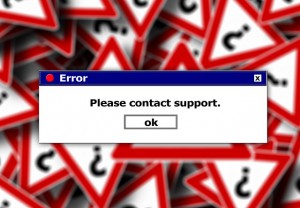Whoops! The 15 Biggest Screw-ups in Internet History
Disclosure: Your support helps keep the site running! We earn a referral fee for some of the services we recommend on this page. Learn more
Everybody makes mistakes sometimes, but when those mistakes are made online by high-profile figures, it’s hard not to stare at the train wreck. Whether you’ve accidentally launched a virus, or given control of your company blog to a stranger, it’s obvious you’ve screwed up big time. Check out these 15 Internet screw-ups that will live in infamy.
- Dreamhosts’ $7.5 Million Billing Mistake: Due to a “fat-fingered” error in 2008, Dreamhost accidentally overbilled almost all of their customers, charging them for nearly a year in hosting fees. Large charges appeared on customers’ credit and debit cards, but Dreamhost promised to make good on refunds, and even said they’d pay for any overdraft fees they caused.
- Trump Gets Trolled: In September 2014, Donald Trump was asked to retweet a picture of a fan’s parents on Twitter. He was later informed that the photo was of Fred and Rose West, two notorious British serial killers. In response, Donald Trump threatened to sue in response to the online prank.
- iTunes Leaks Stargate Atlantis: In 2007, Apple offered what it thought was the season premiere of the sci-fi TV show Stargate Atlantis on iTunes, but actually sold the fourth episode instead. It didn’t take long for the episode to be uploaded onto BitTorrent and other P2P networks, so there was no way out of this screw up. To make up for it, Apple offered the actual season premiere and an iTunes credit for $2. The mistake was caused by a production number mixup.
 Amazon Downtime Takes Out Down Netflix: Amazon AWS went offline in September 2015, taking Netflix, Reddit and Nest with it. A similar outage had occurred in 2013. Amazon loses an estimated $1.1k per minute while its AWS service is offline.
Amazon Downtime Takes Out Down Netflix: Amazon AWS went offline in September 2015, taking Netflix, Reddit and Nest with it. A similar outage had occurred in 2013. Amazon loses an estimated $1.1k per minute while its AWS service is offline.- Viacom Issues a Takedown For its Own Pirated Video: In the midst of a copyright battle with YouTube, Viacom revealed themselves as video pirates themselves. They tried to get a clip removed from YouTube, but they hadn’t yet received permission to use the source video in the clip. Viacom even sent a DCMA takedown notice to the owner of the original content, asking him to take down the clip. This is another unfortunate incident from 2007.
- Lenovo Installed Spyware On Its PCs: In early 2015, Lenovo admitted to installing Superfish tracking software on the computers it was selling to the public. The company admitted that it messed up, and consumers learned to be wary about the software pre-installed on their computer.
- AOL Releases Search Data for 650,000 Users: In an effort to provide research tools to the academic community, AOL accidentally released search data on more than 650,000 users in 2006. Although the data was anonymized, it showed searches for murder, incest, and other unpleasantries. You could also find names, Social Security numbers, addresses, and more.
- Google.com Was Purchased for $12: Google.com was purchased by Sanmay Ved in October 2015, for the princely sum of just $12. Someone at Google forgot to renew one of the most famous and valuable domains in the world. Google thanked him with a financial reward, which he donated to charity.
- Ed Balls Tweets Ed Balls: On 28 April 2011, UK politician Ed Balls accidentally tweeted his own name by accident, instead of typing it into the search box. The tweet was retweeted 37,000 times and took on a new life as a meme. Now, 28 April is ironically celebrated as ‘Ed Balls Day’ by thousands of people on Twitter.
- Nevada Governor Accidentally Posts Outlook Password: On the Governor of Nevada’s website, an instruction guide was posted that told aides how to send out an email on behalf of the governor. This of course included his email, which was a not-very-secure combination of his first and last names. The files were quickly taken down, but still available for some time through Google’s cache.
- Google’s Spider Deletes a Website: One of the website’s users accidentally left an “edit” hyperlink open-and somehow copied this on to every page-which allowed deletion, and the Google spider found these pages, which consequently deleted them. They were able to restore the site with backups, and resolved to never copy and paste content again.
- The Morris Worm: Although the Mooris Worm gave Robert Tappan Morris fame as a hacker, it was actually one big mistake. His intention was to use the worm to see how large the Internet was, but things went bad when the work replicated itself excessively and slowed down computers. This was one of the internet’s first big goofs, having occurred back in 1988.
- Facebook Rolls Out Beacon: In 2009, Facebook launched Beacon, an advertising tracker that monitored users’ movements and published them to their friends. Beacon was a huge privacy mistake for Facebook, and it was forced to backtrack and withdraw it. It now runs a different marketing program under the Beacon brand.
- Symantec Kills the CyberSitter: In 2007, Symantec put out a Security Response update. A program called CyberSitter was tagged as a virus. This led to a number of customers losing both their operating systems and Internet access, including schools and libraries.
- Google Tracks Apple Users’ Activity: Google and Apple have long had a difficult relationship, and Google’s move to track Safari browsing habits didn’t go down well with users. Google had to eventually back down and remove the tracking feature.
